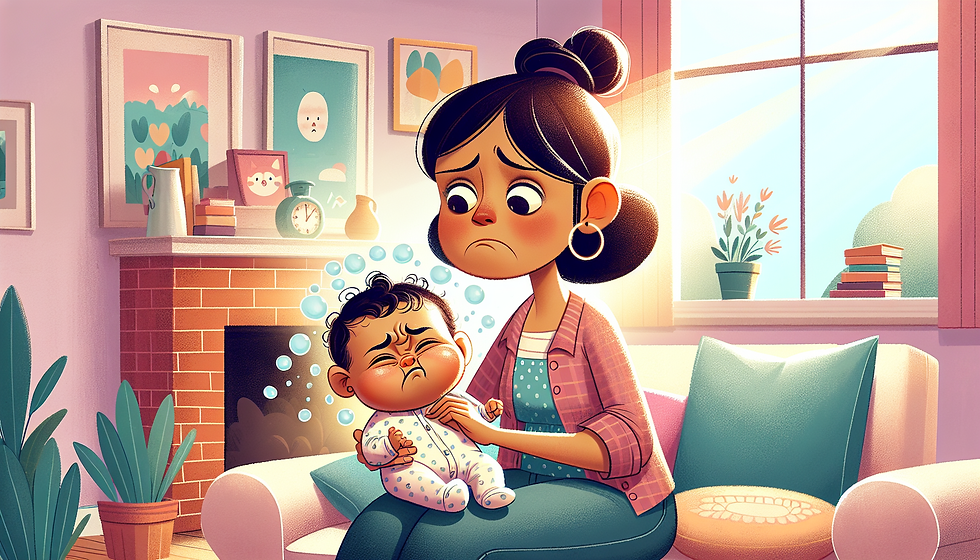Why Won't My Baby Burp & Solutions
- The Parent Corner

- Jan 6
- 7 min read
If you’re wondering ‘why won’t my baby burp,’ you’re not alone. Many parents face this issue, and it can be frustrating. Babies sometimes struggle to burp due to swallowing air during feedings. This can cause discomfort and fussiness. In this article, we’ll explore the common reasons behind this issue and offer practical solutions to help your baby burp comfortably.
Key Takeaways
Understanding why a baby won’t burp involves recognizing factors like feeding methods and the baby’s digestive maturity.
Burp babies during and after feedings based on their individual needs, typically every 2-3 ounces for bottle-fed and when switching breasts for breastfed babies.
Various burping positions, such as the shoulder and lap methods, can enhance effectiveness; observing baby cues for discomfort is essential to determine when to burp.
Understanding Why Your Baby Won't Burp

Burping baby helps eliminate air bubbles that get trapped from swallowing during feedings. Burping relieves discomfort, prevents spitting up, and aids with reflux. However, if your baby won’t burp, it can be due to several reasons. For instance, a strong letdown during nursing or an incorrect bottle flow can cause a baby to swallow excess air during feeding. Understanding these nuances can help you address the issue more effectively.
Different babies have varying needs when it comes to burping. Breastfed babies may not need to be burped as often as bottle-fed babies. This is because they usually swallow less air. Additionally, the maturity of a baby’s digestive system plays a significant role. Some babies, particularly newborns, might struggle to burp due to their still-developing digestive systems. Most babies tend to outgrow these difficulties as their digestive systems mature, typically around 4-6 months.
It’s also essential to note that not all babies need to burp after every feeding; some may rarely need to, depending on their individual needs. If your baby is fussy but not due to burping, this might indicate an issue that requires consulting a doctor. Understanding these factors can help you better manage your baby’s burping needs and ensure their comfort.
Factors Affecting Burping
Burping is a natural reflex that helps release trapped air bubbles in a baby’s stomach. However, several factors can affect a baby’s ability to burp.
How Often Should You Burp Your Baby?
Burping your baby during and after feeding helps prevent discomfort and gas pain. Bottle-feeding infants should be burped every 2 to 3 ounces of milk, while breastfed babies should be burped each time you switch breasts. While these are general guidelines, observing your baby’s cues and comfort during and after feeding is important.
If your baby is prone to gassiness or has reflux, it might be beneficial to pause for burping during feeds. Maintaining an upright position for 10 to 15 minutes after feeding can also help prevent spit-up and discomfort.
Remember, every baby is different, and finding the right burping routine is about observing what works best for your little one.
Signs Your Baby Needs to Burp
Identifying when your baby needs to burp can make the feeding process smoother and more comfortable for them. Common signs include fussiness and discomfort during feeding. If your baby displays behaviors such as pulling away, squirming, or grimacing, it’s essential to pause and try burping them.
Observing your baby arching their back, clenching their fists, or making funny faces can also indicate they need to be burped. These signs are your baby’s way of communicating that they have trapped air that needs to be released. Paying attention to these cues can help you address their discomfort promptly, especially when it comes to a baby burp.
Remember, each baby is unique, and learning to read your baby’s cues will make burping a more effective and less stressful process for both of you.
Different Burping Positions to Try

Finding the right burping position can significantly impact the effectiveness of burping your baby. There are several positions to try, each designed to help release trapped air and provide comfort.
The following subsections will detail specific methods, including the shoulder method, sitting position, arm hold method, and lap method. Experimenting with these positions will help you discover what works best for your baby.
Shoulder Method
The shoulder method is a popular and effective technique for burping babies. To use this method, hold your baby upright on your shoulder, ensuring their baby's chin rests comfortably while you support their head and shoulder.
Gently pat or gently rub their back to encourage burping. This method allows the baby’s upper body to be in an ideal position for releasing trapped air.
Sitting Position
In the sitting position, place your baby on your lap, facing away from you. Support their baby's chin and chest with one hand while gently leaning them forward, ensuring their baby's head is well-supported. Use your other hand to pat their back gently.
This slightly forward, semi-upright position helps in effectively burping your baby without causing discomfort.
Arm Hold Method
The arm hold method involves laying your baby belly down on your forearm, with baby's head in the crook of your elbow and supporting their baby's legs. Ensure that their head is elevated, then gently pat or rub their back to help them burp.
This position can be particularly soothing for the baby while effectively releasing as much air as babies fall asleep with trapped air.
Lap Method
For the lap method, lay your baby face down across your lap, supporting their chin with one hand while you gently pat their back with the other. This position allows gravity to aid in the burping process and can provide comfort after feeding.
Tips for Burping a Sleeping Baby

Burping baby can be a delicate task, but it’s essential to ensure they don’t experience discomfort from trapped air. One effective method is to use slower movements to avoid waking them. Positioning the baby upright is crucial, even while they are asleep. You can try laying them on their tummy on your knees and gently patting their back until the baby falls asleep.
You can burp a baby asleep without fully waking them up. This can be done gently to avoid disturbing their rest. When burping your baby in this state, keep a burp cloth handy to catch any spit-up. Experiment with different positions, such as patting their bottom or gently bouncing them while they sit on your lap. Some positions may be more likely to wake the sleeping baby, so find what works best for your little one.
No method is foolproof, and you may need to try various techniques to find what works for your baby. Patience and gentleness are key to ensuring your baby remains comfortable throughout the process.
Common Challenges and Solutions
Burping can be a challenging task, especially for new parents. Here are some common challenges and practical solutions to help you and your baby:
Tips for Specific Feeding Methods
Different feeding methods can affect a baby’s ability to burp. Here are some tailored tips for bottle feeding, breastfeeding, and combination feeding:
What If My Baby Still Won't Burp?

If your baby still won’t burp despite trying various methods, don’t worry. Some babies may not need to burp after every feeding as they learn to consume milk with less air. However, if your baby shows signs of gas pains, keep trying to burp for another few minutes and change positions. Sometimes, stretching the baby’s body can help release gas.
Consult your pediatrician if conventional methods fail or if your baby continues to show discomfort. They can provide tailored advice and alternative solutions. Remember, every baby is different, and it’s essential to find what works best for your baby.
Your baby may still feel relief from discomfort even without a loud burp. Trying to burp them can be beneficial.
Can a Baby Choke If Not Burped?
A common concern is whether a baby can choke if not burped. The good news is that babies won’t choke if not burped, as they have a natural reflex to manage regurgitated milk. Choking on spit-up is a rare risk associated with not burping a baby. Babies are less likely to choke when lying on their backs since their airway is positioned above their esophagus.
It is also safe to put a baby to sleep without burping them. However, if your baby is particularly gassy, it’s beneficial to try and burp them before laying them down to sleep. This can help ensure they are comfortable and reduce the risk of spit-up during sleep.
Managing Excess Gas and Discomfort

Managing excess gas and discomfort involves proactive steps during and after feeding. A proper latch during breastfeeding is crucial in preventing excess gas. Parents should aim to prevent the baby from swallowing too much air while feeding. Breastfeeding mothers should be mindful of their diet, avoiding foods that can contribute to gas in babies, such as onions, garlic, beans, peas, and spices.
If your baby shows signs of discomfort from gas, consider lying them on their back and gently massaging their tummy. Moving baby’s legs in a cycling motion can help relieve trapped gas.
Spending time on their tummy and feeding in an upright position can reduce gas intake and alleviate discomfort. Gentle massaging in circular motions can be beneficial.
Summary
Burping your baby is an essential practice to ensure their comfort and prevent gas-related discomfort. Understanding why your baby might struggle to burp, recognizing the signs that they need to burp, and trying different burping positions can make a significant difference. Whether your baby is awake or asleep, having a variety of techniques at your disposal will help you find what works best for your little one.
Remember, every baby is unique, and what works for one might not work for another. Be patient and persistent, and don’t hesitate to consult your pediatrician if you have concerns. With time and practice, you’ll find the best methods to keep your baby happy and comfortable.
Frequently Asked Questions
How often should I burp my baby during feeding?
It is advisable to burp bottle-fed babies every 2 to 3 ounces and to burp breastfed babies each time you switch breasts. This helps to reduce the risk of discomfort from gas.
What are common signs that my baby needs to burp?
Common signs that your baby needs to burp include fussiness, pulling away during feeding, squirming, arching their back, clenching fists, and making unusual facial expressions. Recognizing these cues can help ensure your baby's comfort.
Can I burp my baby while they are asleep?
Yes, you can burp a sleeping baby by using gentle movements and keeping them in an upright position. Techniques like laying them on their tummy on your knees or gently bouncing them on your lap can be effective.
What if my baby still won't burp after trying different methods?
If your baby still won't burp after trying various methods, it may be that they don’t need to burp with every feeding. Consulting your pediatrician can provide further guidance tailored to your baby's needs.
Can my baby choke if not burped?
It's generally safe to put your baby to sleep without burping them, as they have a natural reflex to manage any regurgitated milk. Choking on spit-up is considered rare.




Comments